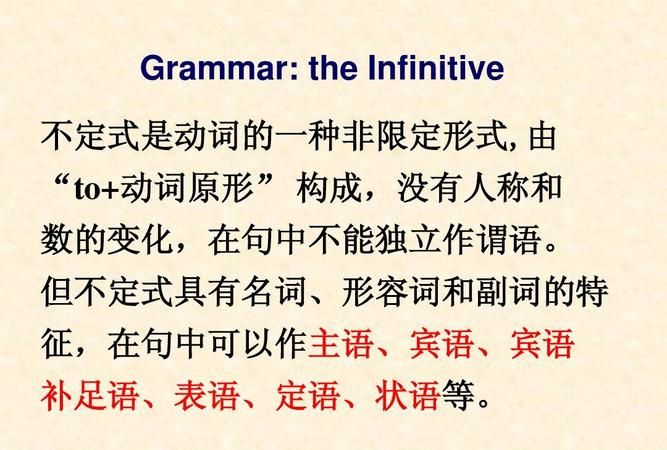本文目录
动词不定式表达的含义
动词不定式用法解读动词不定式是一种活跃的非谓语动词。它在句中起的是名词。形容词或副词的作用,可在句子中作主语。宾语。定语。状语和宾语补足语。动词不定式的形式是#to +动词原形#,但to有时要省去。动词不定式在具体运用时,用不用to,取决于谓语动词的用法:
一。带to的不定式结构
1.我们学过的能直接跟带to的不定式结构的动词主要有:want, ask, tell, hope, learn, try, decide, forget, remember, like ,love, stop, go, come等。
2.动词不定式的否定形式是在不定式前直接加not,即not to do sth.。例如:
Jim told me not to wake up Kate.吉姆告诉我别叫醒凯特。
二。不带to的不定式结构
以下几种情况使用不带to的动词不定式:
1.在固定词组had better之后。注意:had better的否定形式是had better not do sth.。例如:
You had better go home now.你最好现在回家。
It]s cold outside. You]d better not go out.外面很冷,你最好不要出去。
2.在let,make,see, feel, watch,hear等感官或使役动词后,要跟不带to的动词不定式作宾语补足语。例如:
I made them give me the money back.我迫使他们把钱还给我。
I didn]t see you come in.我没看见你进来。
3.在引导疑问句的why not之后。
#Why not+不带to的不定式#是Why don]t you do…的省略,可以用来提出建议或劝告。例如:
Why not go with us。为什么不和我们一起去呢。
Why not take a holiday。=Why don]t you take a holiday。为什么不休个假呢。
三。动词不定式作主语
不定式结构作主语时,现代英语倾向于采用it作形式主语,而把不定式结构后置的形式。参见本期本面《#小鬼it#它当家》中it作形式主语的用法。
四。动词不定式作定语
不定式作定语,要放在它所修饰的名词或代词的后面。例如:
I have nothing to say on this question.对这个问题我无可奉告。
五。动词不定式作宾语
有的及物动词要求跟复合宾语(即宾语+宾语补足语)。如果其中的宾语是不定式短语,则必须将形式宾语it放在宾语的位置上,而将不定式短语(真正的宾语)放在宾语补足语之前。例如:
I find it useful to learn English well.我发现学好英语很有用。
We thought it wrong not to tell her.我们认为不告诉她是错误的。
六。动词不定式作宾语补足语
动词不定式作宾语补足语是动词不定式用法的一个重点,学习时要注意以下三种情况:
1.作动词ask, like, tell等的宾语补足语时,动词不定式符号to不可以省略。例如:
He asked me to talk about English study.他请我谈谈英语学习。
2.作使役动词let, have, make以及感官动词feel, hear, see, watch等的宾语补足语时,动词不定式符号to要省略。例如:
The teacher made him say the word like this.老师让他像这样说这个单词。
3.作动词help的宾语补足语时,动词不定式符号to可以带,也可以不带。例如:
Could you help me (to) carry the heavy box。你能帮我搬这个重箱子吗。
七。动词不定式作状语
动词不定式及其短语具有副词的特性,可在句中用作状语。
1.放在句首也可以放在句尾表示目的等。例如: He stopped to have a rest.他停下来休息。
2.跟在作表语的形容词或过去分词的后面。例如:
I]m sorry to hear that.听到这事我感到很难过。
3.用在too... to...结构中。例如:
He is too young to understand all that.他太年轻了,不能理解这件事。

什么叫动词不定式
动词不定式是一种非限定性动词,由to+动词原形构成,但在有些情况下to可以省略。它还是属于动词,本身可以带宾语和状语。动词不定式在句中可以作主语、宾语、表语、定语和状语,还可用在复合结构中,而且有完成式、进行式、完成进行式和否定形式。动词不定式的被动形式除了一般形式外还有其完成式和进行式。
主动形式 被动形式
一般式 (not) to make (not) to be made
完成式 (not) to have made (not) to have been made
进行式 (not) to be making
完成进行式 (not) to have been making
It's a great honour to be invited to Mary's birthday party.(不定式作主语)
It was impossible for lost time to be made up.(不定式作主语)
I wish to be sent to work in the country.(不定式作宾语)
Can you tell me which is the car to be repaired?(不定式作定语)
He went to the hospital to be examined.(不定式作状语)
在There be结构中,修饰主语的不定式可用被动,也可用主动。如:There are still many things to t ake care of (to be taken care of).但有时两种形式表达的意思不同,如:These is nothing to do now.( We have nothing to do now.) There is nothing to be done now.(We can do nothing now.)
1) 现在时:一般现在时表示的动词,有时与谓语动词表示的动作同时发生,有时发生在谓语动词的动作之后。
He seems to know this.
I hope to see you again. = I hope that I'll see you again. 我希望再见到你。
2) 完成时:表示的动作发生在谓语动词表示的动作之前。
I'm sorry to have given you so much trouble.
He seems to have caught a cold.
3) 进行时: 表示动作正在进行,与谓语动词表示的动作同时发生。
He seems to be eating something.
4) 完成进行时:
She is known to have been wreaking on the problem for many years.
疑问词who,what,which,when,where,whether,how后可接不定式构成不定式短语,在句中作主语、宾语、表 语等。
一、作宾语
1) 动词+ 不定式
afford aim appear agree arrange ask be decide bother care choose come dare demand desire determine expect elect endeavor hope fail happen help hesitate learn long mean manage offer ought plan prepare pretend promise refuse seem tend wait wish undertake
举例:
The driver failed to see the other car in time.
司机没能及时看见另一辆车。
I happen to know the answer to your question.
我碰巧知道你那道问题的答案。
2)动词+不定式 ;动词+宾语+不定式
ask, beg, choose, expect , hate, help intend like, love, need prefer, prepare, promise, want, wish…
I like to keep everything tidy. 我喜欢每件东西都保持整洁。
I like you to keep everything tidy. 我喜欢你年使每件东西都保持整洁。
I want to speak to Tom. 我想和汤姆谈话。
I want you to speak to Tom. 我想让你和汤姆谈话。
3) 动词+疑问词+ to
decide, know, consider forget, learn, remember, show, understand, see, wonder, hear, find out, explain, tell
Please show us how to do that. 请演示给我们如何去做。
There are so many kinds of tape-recorders on sale that I can't make up my mind which to buy.有这么多的录音机,我都拿不定主意买哪一种。
注意:疑问词带不定式在句中作成分时,谓语动词用单数。
The question is how to put it into practice.
问题是怎样把它付诸实施。
4)以下动词后,只能跟不定式作宾语。
如:agree,ask,aim,arrange,choose,decide,demand,expect,fail ,help,hope,lean,long,manage,offer,plan,prepare,
pretend,promise,refuse,wish 等,这些词大部分可接th at引导的从句。如:
I decided to ask for my money back.
I decided that I would ask for my money back.
When our visit to the farm was over,we expected to startback on foot.
When our visit to the farm was over, we expected that wewould start back on foot.
5)当复合宾语中的宾语是不定式时,先用形式宾语it代替不定式,把不定式置于补语之后,即:主语+动 词+it+补语+to do句式。如:
We think it quite important for us to learn a foreignlanguage well.
He feels it his duty to help the poor.
二、作补语
1) 动词+宾语+不定式(to do)
advise allow appoint believe cause challenge command compel consider declare drive enable encourage find forbid force guess hire imagine impel induce inform instruct invite judge know like order permit persuade remind report request require select send state suppose tell think train trust understand urge warn
例句:
a. Father will not allow us to play on the street.
父亲不让我们在街上玩耍。
b. We believe him to be guilty.
我们相信他是有罪的。
Find 的特殊用法:
Find 后可用分词做宾补,或先加形式宾语,再加形容词,最后加带to 的动词不定式。find后也可带一个从句。此类动词还有get,have。
I found him lying on the ground.
I found it important to learn.
I found that to learn English is important.
典型例题:
The next morning she found the man ___ in bed,dead.
A. lying B. lie C. lay D. laying
答案:A.find的宾语后面,用分词或分词短语,起宾语补足语作用。现在分词表达主动,也表达正在进行,过去分词表达被动。
2) to + be 的不定式结构,作补语的动词。
Acknowledge, believe, consider, think, declare(声称), discover, fancy(设想), feel find, guess, judge, imagine, know, prove, see(理解), show, suppose, take(以为), understand
We consider Tom to be one of the best students in our class.
我们认为汤姆是班上最好的学生之一。
典型例题
Charles Babbage is generally considered ___ the first computer.
A. to invent B. inventing C. to have invented D. having invented
答案:A. 由consider to dosth. 排除B、D。. 此句只说明发明这一个事实,不定式后用原形即可。而C为现在完成时,发明为点动词一般不用完成时,且此处也不强调对现在的影响,因此不选C。
3) to be +形容词
Seem, appear, be said, be supposed, be believed, be thought, be known, be reported, hope, wish, desire, want, plan, expect, mean…
The book is believed to be uninteresting.
人们认为这本书没什么意思。
4) there be+不定式
believe, expect, intend, like, love, mean, prefer, want, wish, undrstand
We didn't expect there to be so many people there.我们没料到会有那么多人在哪里。
有些动词需用as 短语做补语,如regard, think believe, take, consider.
We regard Tom as our best teacher. 我们认为汤姆是我们最好的老师。
Mary took him as her father . 玛丽把他当作自己的父亲。
三、作主语
动词不定式作主语时,句子的谓语动词常用单数,其位置有以下两种:
(1)把不定式置于句首。如:
To get there by bike will take us half an hour.
(2)用it作形式主语,把真正的主语不定式置于句后,常用于下列句式中。如:
①It+be+名词+to do
It's our duty to take good care of the old.
②It takes sb+some time+to do
How long did it take you to finish the work?
③It+be+形容词+for sb+to do
It is difficult for us to finish writing the compositionin a quarter of an hour.
④It+be+形容词+of sb+to do
It is stupid of you to write down everything the teachersays.
⑤It seems(appears)+形容词+to do
It seemed impossible to save money.
在句型③中,常用表示客观情况的形容词,如:difficult,easy,hard,important,impossible,necessary 等;在句型④中,常用careless,clever,good,foolish,honest,kind,lazy,nice,right,silly,stupid,wise等 表示赞扬或批评的词。在不定式前的sb,可看作其逻辑主语。这一句式有时相当于Sb is+形容词+to do句式 ,如:It'skind of you to help me with my English.=You are kind to helpme with my English.
(3)举例
1) It's easy (for me) to do that.我做这事太容易了
easy, difficult, hard, important, possible, impossible, comfortable, necessary, better;
the first, the next, the last, the best, too much, too little, not enough
It's so nice to hear your voice.
听到你的声音真高兴。
It's necessary for you to lock the car when you do not use it.
当你不用车的时候,锁车是有必要的。
2) It's very kind of you to help us. 他帮助我们,他真好。
Kind, nice, stupid, rude, clever, foolish, thoughtful, thoughtless, brave, considerate(考虑周到的), silly, selfish(自私的)
例句:
It was silly of us to believe him. 我们真愚蠢,竟然相信了他。
It seemed selfish of him not to give them anything. 他不给他们任何东西,这显得太自私了。
注意:1) 其他系动词如,look,appear等也可用于此句型
2) 不定式作为句子成分时,动词用单数形式。
3) 当不定式作主语的句子中又有一个不定式作表语时,不能用It is… to…的句型
(对)To see is to believe. 百闻不如一见。
(错)It is to believe to see.
四、作表语
不定式作表语表示具体动作或将来动作;动名词作表语表示抽象的一般行为。
①To be kind to the enemy is to be cruel to the people.
②My chief purpose is to point out the difficulties ofthe matter.
③What I would suggest is to put off the meeting.
当主语和表语都是不定式时,其含义一是条件,一是结果(例①)。当主语是aim,duty,hope,idea,mista ke,plan,purpose,suggestion等为中心词的名词词组(例②)时,或以what引导的名词性分句(例③),不定 式说明主语的内容。
④Our work is serving the people.
⑤What he likes is taking a walk after supper.
⑥The story told by Mr.Wang is interesting.
④⑤句动名词作表语,与主语部分可以转换,如Serving thepeople is out work,而⑥句中是现在分词作 表语,说明主语的性质、状态,现在分词具有形容词的各种特征,另外,动名词作表语还应与进行时态区别开 来。
五、作定语
⒈不定式作定语
不定式在句中作定语,置于被修饰的名词或代词之后。如:
①The next train to arrive is from Washington.
②Have you anything to be taken to your sister?
③Do you have anything to say on the question?
④Would you please give me some paper to write on?
⑤My wish to visit France has come true at last.
不定式短语作定语和被修饰词之间表示以下关系:
(1)表示将来的动作(例①)。
(2)与被修饰词之间有动宾关系,如是不及物动词,则需加介词(例④)。
(3)与被修饰词之间有动宾关系,同时与句中其它词之间又有逻辑上的主谓关系时,尽管有被动含义,却仍 用主动语态(例③);如只有动宾关系,而无逻辑上的主谓关系,则需用被动语态(例②)。
(4)不定式作定语时,一般可转换为定语从句,例①to arrive=that will arrive。
六、作状语
1)目的状语
To… only to (仅仅为了), in order to, so as to, so(such)… as to… (如此……以便……)
He ran so fast as to catch the first bus. 他飞快地跑以便赶上第一班车。
I come here only to say good-bye to you. 我来仅仅是向你告别。
2)作结果状语,表事先没有预料到的,要放在句子后面。
What have I said to make you angry.
He searched the room only to find nothing.
3) 表原因
I'm glad to see you.

不定式是什么
在英语语法中,不定式是指动词中的一种不带词形变化从而不指示人称、数量、时态的一种形式。
它之所以被称做不定式,是因为动词不被限定,或者说不被词形变化所局限。不定式属于非谓语动词形式。
动词不定式可以作以上各种成分,但它毕竟是动词,所以有动词的属性。

扩展资料
动词不定式及其短语还可以有自己的宾语、状语,虽然动词不定式在语法上没有表面上的直接主语,但它表达的意义是动作,这一动作一定由使动者(动词的使用者)发出。
对于英语来说接不定式的单词多为“打算”“计划”“希望”“将要做某事”等表示未来(未做的事)的动词。同样与不定式表示不同,现在分词表示正在进行,一般性或经常性发生的行为。
如果动词不定式的逻辑主语是这个不定式所表示的动作的承受者,不定式一般要用被动语态形式。如:
It's a great honour to be invited to Mary's birthday party.(不定式作主语是被动语态to be invited是被邀请)——意思:能被邀请参加玛丽的生日聚会真是太荣幸了。
It was impossible for lost time to be made up.(不定式作主语)——意思:
弥补损失的时间是不可能的。
I wish to be sent to work in the country.(不定式作宾语)——意思:
我想被派到这个国家工作
什么叫动词不定式短语
动词不定式是一种活跃的非谓语动词。它在句中起的是名词。形容词或副词的作用,可在句子中作主语。宾语。定语。状语和宾语补足语。动词不定式的形式是"to +动词原形",但to有时要省去。动词不定式在具体运用时,用不用to,取决于谓语动词的用法:
一。带to的不定式结构
1.我们学过的能直接跟带to的不定式结构的动词主要有:want, ask, tell, hope, learn, try, decide, forget, remember, like ,love, stop, go, come等。
2.动词不定式的否定形式是在不定式前直接加not,即not to do sth.。例如:
Jim told me not to wake up Kate.吉姆告诉我别叫醒凯特。
二。不带to的不定式结构
以下几种情况使用不带to的动词不定式:
1.在固定词组had better之后。注意:had better的否定形式是had better not do sth.。例如:
You had better go home now.你最好现在回家。
It's cold outside. You'd better not go out.外面很冷,你最好不要出去。
2.在let,make,see, feel, watch,hear等感官或使役动词后,要跟不带to的动词不定式作宾语补足语。例如:
I made them give me the money back.我迫使他们把钱还给我。
I didn't see you come in.我没看见你进来。
3.在引导疑问句的why not之后。
"Why not+不带to的不定式"是Why don't you do…的省略,可以用来提出建议或劝告。例如:
Why not go with us。为什么不和我们一起去呢。
Why not take a holiday。=Why don't you take a holiday。为什么不休个假呢。
三。动词不定式作主语
不定式结构作主语时,现代英语倾向于采用it作形式主语,而把不定式结构后置的形式。参见本期本面《"小鬼it"它当家》中it作形式主语的用法。
四。动词不定式作定语
不定式作定语,要放在它所修饰的名词或代词的后面。例如:
I have nothing to say on this question.对这个问题我无可奉告。
五。动词不定式作宾语
有的及物动词要求跟复合宾语(即宾语+宾语补足语)。如果其中的宾语是不定式短语,则必须将形式宾语it放在宾语的位置上,而将不定式短语(真正的宾语)放在宾语补足语之前。例如:
I find it useful to learn English well.我发现学好英语很有用。
We thought it wrong not to tell her.我们认为不告诉她是错误的。
六。动词不定式作宾语补足语
动词不定式作宾语补足语是动词不定式用法的一个重点,学习时要注意以下三种情况:
1.作动词ask, like, tell等的宾语补足语时,动词不定式符号to不可以省略。例如:
He asked me to talk about English study.他请我谈谈英语学习。
2.作使役动词let, have, make以及感官动词feel, hear, see, watch等的宾语补足语时,动词不定式符号to要省略。例如:
The teacher made him say the word like this.老师让他像这样说这个单词。
3.作动词help的宾语补足语时,动词不定式符号to可以带,也可以不带。例如:
Could you help me (to) carry the heavy box。你能帮我搬这个重箱子吗。
七。动词不定式作状语
动词不定式及其短语具有副词的特性,可在句中用作状语。
1.放在句首也可以放在句尾表示目的等。例如: He stopped to have a rest.他停下来休息。
2.跟在作表语的形容词或过去分词的后面。例如:
I'm sorry to hear that.听到这事我感到很难过。
3.用在too... to...结构中。例如:
He is too young to understand all that.他太年轻了,不能理解这件事。

以上就是关于不定式是个什么鬼 ,动词不定式表达的含义的全部内容,以及不定式是个什么鬼 的相关内容,希望能够帮到您。

